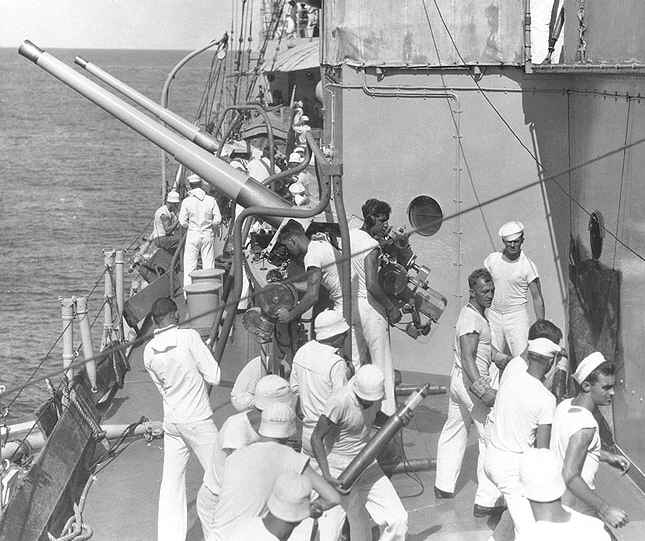|
Although considered to be dual-purpose weapons, these guns had limited effectiveness in either role, as they fired light-weight shells and were manually operated, meaning that they could not be fitted for RPC. However, the invention of the VT fuze and the addition late in the war of power operation together with the Mark 51 director system greatly improved their effectiveness as AAA guns, giving the later marks of this weapon a new lease on life. In the fall of 1945, CinCPac considered that a 3"/50 (7.62 cm) with director control, RPC and VT ammunition was superior to a twin Bofors 40 mm mount and at least equivalent to a quad Bofors 40 mm mount. There was a design defect in the breech block of the Mark 22. When the breech block was closed, the firing pin could stick out and strike the cartridge igniter and accidentally fire the gun. Navy ordnance publications for this weapon recommended lubricating the firing mechanism with light machine oil instead of grease as a correction for the problem, but this was not always successful. The Mark 10 was derived from the 3"/50 (7.62 cm) Mark 6 with a modified breech that was of the vertical sliding wedge type. Marks 10, 17 and 20 were built-up guns with A tube, jacket and hoop. Mark 17 guns were intended for wet mountings and had the bore and external working surfaces chrome plated and the chase painted with red lead. Mark 18 was intended for wet mountings and manufactured from a copper-nickel alloy with A tube, jacket, screwed and shrunk breech housing. Mark 19 had monobloc construction and thus a lighter gun. Marks 21 and 22 were very similar apart from a collar on the chase on the Mark 22. This was intended for use with a concentric counter-recoil spring, which was used only on Mark 24 mountings during World War II. However, this feature led to this barrel being selected for the post-war automatic mountings. See the data page on the 3"/50RF (7.62 cm) for additional information. Both the Mark 21 and the Mark 22 had chromium plated bores and autofretted monobloc barrels secured to the breech housings by bayonet joints. All marks used a semi-automatic vertical sliding breech block. The data that follows is for the Mark 21 Mod 0 unless otherwise specified. |

3"/50 (7.6 2 cm) target practice aboard
USS Milwaukee CL-5 in December 1928
|
| .
|